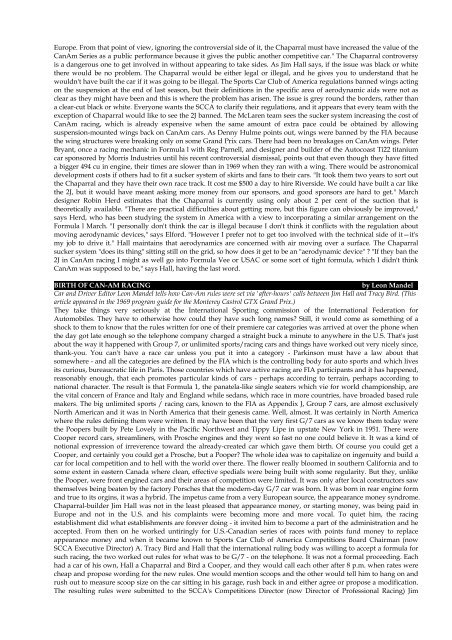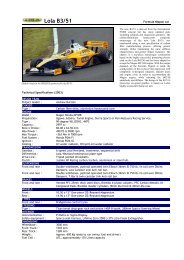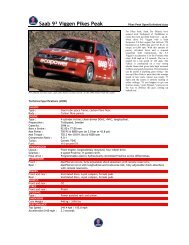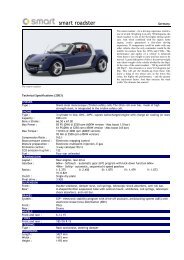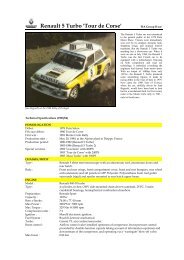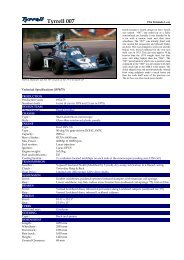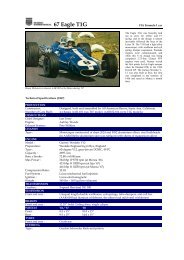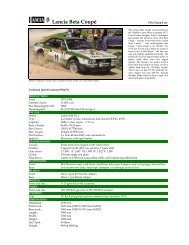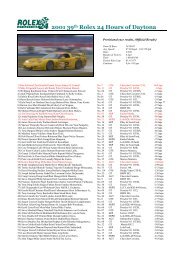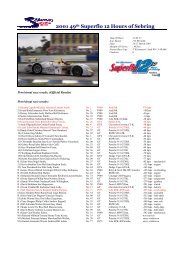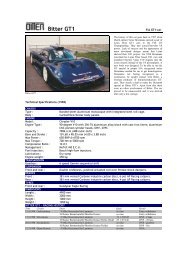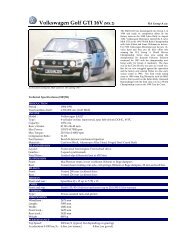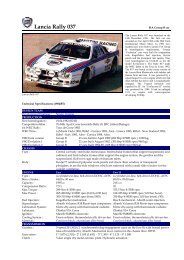70 Chaparral 2J - Motorsports Almanac
70 Chaparral 2J - Motorsports Almanac
70 Chaparral 2J - Motorsports Almanac
You also want an ePaper? Increase the reach of your titles
YUMPU automatically turns print PDFs into web optimized ePapers that Google loves.
Europe. From that point of view, ignoring the controversial side of it, the <strong>Chaparral</strong> must have increased the value of the<br />
CanAm Series as a public performance because it gives the public another competitive car." The <strong>Chaparral</strong> controversy<br />
is a dangerous one to get involved in without appearing to take sides. As Jim Hall says, if the issue was black or white<br />
there would be no problem. The <strong>Chaparral</strong> would be either legal or illegal, and he gives you to understand that he<br />
wouldn't have built the car if it was going to be illegal. The Sports Car Club of America regulations banned wings acting<br />
on the suspension at the end of last season, but their definitions in the specific area of aerodynamic aids were not as<br />
clear as they might have been and this is where the problem has arisen. The issue is grey round the borders, rather than<br />
a clear-cut black or white. Everyone wants the SCCA to clarify their regulations, and it appears that every team with the<br />
exception of <strong>Chaparral</strong> would like to see the <strong>2J</strong> banned. The McLaren team sees the sucker system increasing the cost of<br />
CanAm racing, which is already expensive when the same amount of extra pace could be obtained by allowing<br />
suspension-mounted wings back on CanAm cars. As Denny Hulme points out, wings were banned by the FIA because<br />
the wing structures were breaking only on some Grand Prix cars. There had been no breakages on CanAm wings. Peter<br />
Bryant, once a racing mechanic in Formula l with Reg Parnell, and designer and builder of the Autocoast Ti22 titanium<br />
car sponsored by Morris Industries until his recent controversial dismissal, points out that even though they have fitted<br />
a bigger 494 cu in engine, their times are slower than in 1969 when they ran with a wing. There would be astronomical<br />
development costs if others had to fit a sucker system of skirts and fans to their cars. "It took them two years to sort out<br />
the <strong>Chaparral</strong> and they have their own race track. It cost me $500 a day to hire Riverside. We could have built a car like<br />
the <strong>2J</strong>, but it would have meant asking more money from our sponsors, and good sponsors are hard to get." March<br />
designer Robin Herd estimates that the <strong>Chaparral</strong> is currently using only about 2 per cent of the suction that is<br />
theoretically available. "There are practical difficulties about getting more, but this figure can obviously be improved,"<br />
says Herd, who has been studying the system in America with a view to incorporating a similar arrangement on the<br />
Formula l March. "I personally don't think the car is illegal because I don't think it conflicts with the regulation about<br />
moving aerodynamic devices," says Elford. "However I prefer not to get too involved with the technical side of it—it's<br />
my job to drive it." Hall maintains that aerodynamics are concerned with air moving over a surface. The <strong>Chaparral</strong><br />
sucker system "does its thing" sitting still on the grid, so how does it get to be an "aerodynamic device" ? "If they ban the<br />
<strong>2J</strong> in CanAm racing I might as well go into Formula Vee or USAC or some sort of tight formula, which I didn't think<br />
CanAm was supposed to be," says Hall, having the last word.<br />
BIRTH OF CAN-AM RACING by Leon Mandel<br />
Car and Driver Editor Leon Mandel tells how Can-Am rules were set via 'after-hours' calls between Jim Hall and Tracy Bird. (This<br />
article appeared in the 1969 program guide for the Monterey Castrol GTX Grand Prix.)<br />
They take things very seriously at the International Sporting commission of the International Federation for<br />
Automobiles. They have to otherwise how could they have such long names? Still, it would come as something of a<br />
shock to them to know that the rules written for one of their premiere car categories was arrived at over the phone when<br />
the day got late enough so the telephone company charged a straight buck a minute to anywhere in the U.S. That's just<br />
about the way it happened with Group 7, or unlimited sports/racing cars and things have worked out very nicely since,<br />
thank-you. You can't have a race car unless you put it into a category - Parkinson must have a law about that<br />
somewhere - and all the categories are defined by the FIA which is the controlling body for auto sports and which lives<br />
its curious, bureaucratic life in Paris. Those countries which have active racing are FIA participants and it has happened,<br />
reasonably enough, that each promotes particular kinds of cars - perhaps according to terrain, perhaps according to<br />
national character. The result is that Formula 1, the panatela-like single seaters which vie for world championship, are<br />
the vital concern of France and Italy and England while sedans, which race in more countries, have broaded based rule<br />
makers. The big unlimited sports / racing cars, known to the FIA as Appendix J, Group 7 cars, are almost exclusively<br />
North American and it was in North America that their genesis came. Well, almost. It was certainly in North America<br />
where the rules defining them were written. It may have been that the very first G/7 cars as we know them today were<br />
the Poopers built by Pete Lovely in the Pacific Northwest and Tippy Lipe in upstate New York in 1951. There were<br />
Cooper record cars, streamliners, with Prosche engines and they went so fast no one could believe it. It was a kind of<br />
notional expression of irreverence toward the already-created car which gave them birth. Of course you could get a<br />
Cooper, and certainly you could get a Prosche, but a Pooper? The whole idea was to capitalize on ingenuity and build a<br />
car for local competition and to hell with the world over there. The flower really bloomed in southern California and to<br />
some extent in eastern Canada where clean, effective spedials were being built with some regularity. But they, unlike<br />
the Pooper, were front engined cars and their areas of competition were limited. It was only after local constructors saw<br />
themselves being beaten by the factory Porsches that the modern-day G/7 car was born. It was born in rear engine form<br />
and true to its orgins, it was a hybrid. The impetus came from a very European source, the appearance money syndrome.<br />
<strong>Chaparral</strong>-builder Jim Hall was not in the least pleased that appearance money, or starting money, was being paid in<br />
Europe and not in the U.S. and his complaints were becoming more and more vocal. To quiet him, the racing<br />
establishment did what establishments are forever doing - it invited him to become a part of the administration and he<br />
accepted. From then on he worked untiringly for U.S.-Canadian series of races with points fund money to replace<br />
appearance money and when it became known to Sports Car Club of America Competitions Board Chairman (now<br />
SCCA Executive Director) A. Tracy Bird and Hall that the international ruling body was willing to accept a formula for<br />
such racing, the two worked out rules for what was to be G/7 - on the telephone. It was not a formal proceeding. Each<br />
had a car of his own, Hall a <strong>Chaparral</strong> and Bird a Cooper, and they would call each other after 8 p.m. when rates were<br />
cheap and propose wording for the new rules. One would mention scoops and the other would tell him to hang on and<br />
rush out to measure scoop size on the car sitting in his garage, rush back in and either agree or propose a modification.<br />
The resulting rules were submitted to the SCCA's Competitions Director (now Director of Professional Racing) Jim


